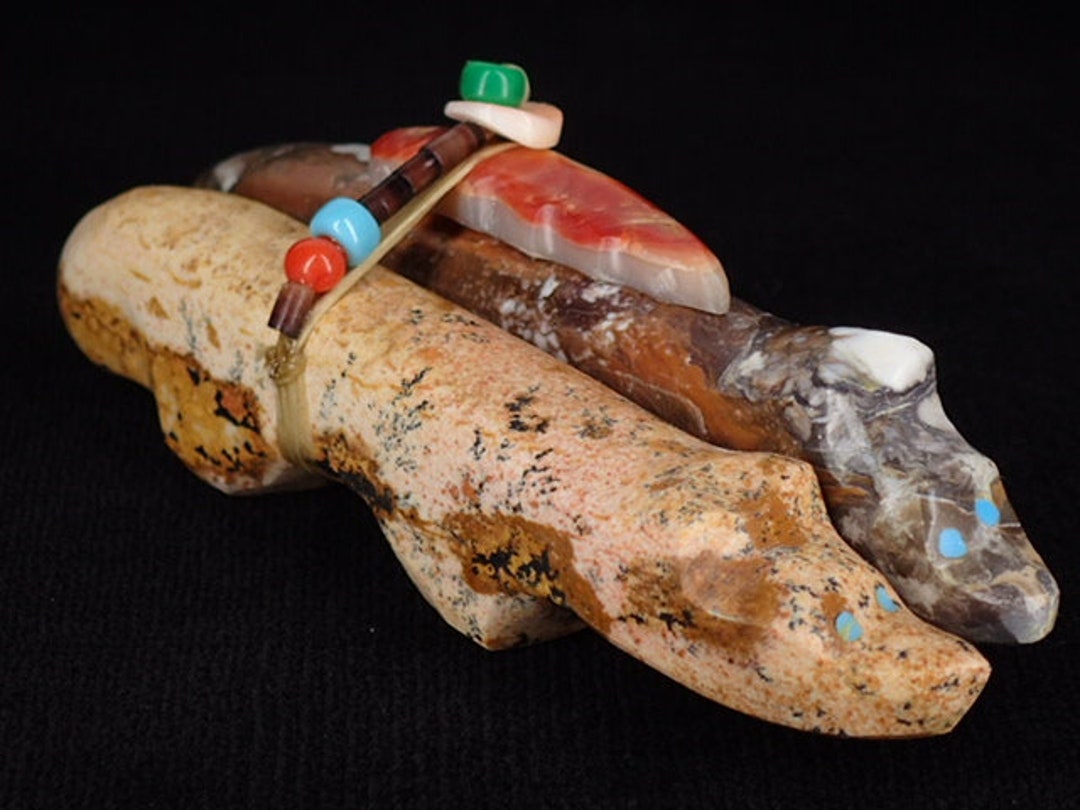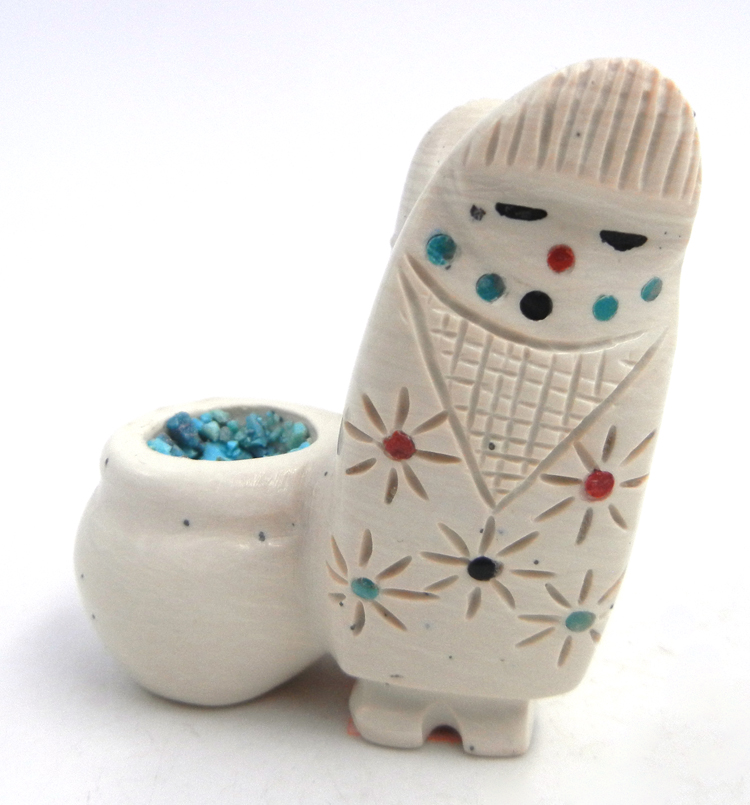
Of course, here is an article about Zuni fetish carvings in a journalistic style, approximately 1200 words, with interesting facts and quotes integrated.
Whispers in Stone: The Enduring Magic of Zuni Fetish Carvings
In the high desert plains of western New Mexico, nestled amidst ancient mesas and the flowing Zuni River, lies the Zuni Pueblo, a place where time seems to slow, and the pulse of a vibrant, living tradition beats strong. Here, for centuries, the Zuni people have sculpted small, powerful figures from stone – an art form known as fetish carving. These are not mere decorative objects; they are sacred vessels, imbued with the spirit of the animals they represent, serving as conduits for prayer, protection, and a profound connection to the natural world.

More than just a craft, Zuni fetish carving is a spiritual practice, a testament to a worldview deeply rooted in reciprocity with nature. Each carving, typically no larger than a human palm, embodies the essence of an animal, believed to possess unique strengths, wisdom, and protective qualities. They are companions on life’s journey, offering guidance, bringing luck, and fostering harmony.
The Heart of the Stone: What is a Zuni Fetish?
To understand Zuni fetishes, one must first shed Western interpretations of the word "fetish" as an object of irrational reverence or sexual fixation. In the Zuni context, a fetish is a spiritual tool, a receptacle for the mana or power of the animal it represents. "They are not idols to be worshipped," explains a knowledgeable Pueblo art dealer, who prefers to remain unnamed to respect cultural sensitivities. "Rather, they are living prayers, reminders of the sacred bond between humans and the animal kingdom, and aids in focusing intent and gratitude."
The Zuni believe that animals are powerful beings, each with distinct attributes that can be called upon for specific purposes. A fetish carving serves as a physical manifestation of that animal’s spirit, allowing the owner to tap into its inherent power. This belief system is integral to Zuni cosmology, where all living things are interconnected and possess a vital spirit.
A Pantheon of Protectors: The Animals and Their Meanings
The pantheon of Zuni fetish animals is rich and diverse, broadly categorized into six "Prey Gods" or "Directional Animals," along with other significant creatures. Each animal embodies specific characteristics, carefully observed and revered by generations of Zuni people:
-

The Bear (West): Perhaps the most iconic Zuni fetish, the bear symbolizes strength, self-knowledge, healing, and the power to overcome adversity. Often depicted with an open mouth, as if roaring or speaking ancient wisdom, the bear is a protector and a bringer of inner peace. Its medicine is particularly sought for physical and spiritual healing.
-
The Mountain Lion (North): A fierce and elusive hunter, the mountain lion (also known as the puma or cougar) represents leadership, courage, and successful hunting. It embodies the spirit of a true hunter, not just of game, but of personal goals and aspirations. Owning a mountain lion fetish is believed to enhance one’s focus and determination.
-
The Wolf (East): Known for its pack loyalty, intelligence, and endurance, the wolf fetish signifies faithfulness, family unity, and the ability to find one’s way through difficult times. It is a guide, a teacher, and a symbol of the collective strength found in community.
-
The Badger (South): A tenacious and resourceful digger, the badger symbolizes persistence, passion, and the ability to find and hold onto what is important. It is also associated with healing due to its knowledge of roots and herbs found underground. The badger encourages us to dig deep within ourselves for truth and strength.
-
The Eagle (Zenith/Sky): As a creature of the sky, the eagle represents spiritual connection, higher wisdom, and the ability to see things from a broader perspective. It is a messenger to the Creator, carrying prayers and bringing visions. An eagle fetish is a powerful symbol of freedom and transcendence.
-
The Mole (Nadir/Underworld): The mole, living beneath the earth, embodies connection to the roots, the hidden aspects of life, and the ability to delve deep for insight and understanding. It represents the unseen forces and the wisdom that lies beneath the surface.
Beyond these primary six, other significant animals include:
- Frog: Associated with rain, fertility, and abundance, crucial in the arid Southwest.
- Turtle: Symbolizes self-reliance, protection, and a long life, carrying its home on its back.
- Snake: Represents transformation, healing, and lightning, often linked to rain and water.
- Hummingbird: A messenger of joy, lightness of being, and the ability to find sweetness in life.
The Adornments: Bundles of Power
What often sets Zuni fetishes apart visually are their "medicine bundles" or "ti’kwa" – small offerings tied to the carving. These bundles are not merely decorative; they are integral to the fetish’s spiritual efficacy, amplifying its power and providing sustenance to the animal spirit within. A typical bundle might include:
- Arrowheads: Often ancient, broken, or flaked from flint, obsidian, or chert, these symbolize protection, successful hunting, and the ability to pierce through obstacles.
- Feathers: Represent prayer, connection to the sky world, and the ability to carry intentions to the spirits.
- Turquoise: A sacred stone to many Southwestern tribes, turquoise signifies health, protection, prosperity, and connection to the sky and water.
- Coral: Represents life force, energy, and the connection to the sea, a source of life.
- Shell: Symbolizes water, fertility, and the life-giving aspects of the ocean.
- Heishe (small shell beads): Often used in necklaces, here they represent unity and continuity.
- Cornmeal: A traditional offering, representing nourishment, life, and prayer.
These elements are carefully chosen and bundled with sinew or cotton thread, often with a blessing and prayer by the carver. The bundle is a direct offering, a sign of respect and reciprocity, acknowledging the spirit of the animal and its willingness to share its power.
The Hands That Carve: Generations of Wisdom
Zuni fetish carving is a multi-generational art form, passed down through families, often from grandparents to grandchildren. The act of carving itself is a meditative and prayerful process. Carvers traditionally begin by selecting stones that speak to them, believing that the spirit of the animal already resides within the raw material. Common materials include serpentine, alabaster, marble, jet, turquoise, shell, and even antler.
Each carver develops a distinctive style, yet all adhere to traditional forms and meanings. Some carvings are highly stylized, almost abstract, while others are more naturalistic, capturing the subtle movements and expressions of the animal. The Zuni emphasis is on the spirit within, rather than perfect anatomical representation. The finish might be highly polished or left with a more natural, matte texture, reflecting the carver’s artistic choice and the stone’s inherent qualities.
One of the most renowned Zuni carving families is the Leekya Deyuse family, whose patriarch, Leekya Deyuse (c. 1889–1966), was a master carver whose work is highly sought after. His influence, along with that of other early masters like Theodore Kucate and Horace Iule, helped shape the contemporary Zuni fetish tradition. Today, hundreds of Zuni individuals carry on this legacy, including names like the Natewa family, the Boone family, and Lena Boone, a celebrated carver known for her distinctive style and deep spiritual connection to her craft.
A Living Tradition in a Modern World
The Zuni Pueblo, with a population of around 10,000, is unique among Native American communities for maintaining a strong, cohesive cultural identity and language. Their traditional practices, including fetish carving, are not relics of the past but living, evolving traditions that adapt while retaining their core spiritual essence.
The increased interest in Native American art has brought both opportunities and challenges. On one hand, it provides economic sustenance for Zuni families and allows their culture to be appreciated by a wider audience. On the other hand, it raises concerns about cultural appropriation, mass production of inauthentic pieces, and the commodification of sacred objects.
"It’s crucial for buyers to understand that these aren’t just trinkets," stresses the art dealer. "They are part of a living spiritual practice. When you purchase a Zuni fetish, especially from a Zuni artist or a reputable dealer who works directly with the Pueblo, you are supporting a culture, a family, and a sacred way of life." Authentic Zuni fetishes are usually signed by the artist, often with their initial or a unique mark, and accompanied by a certificate of authenticity if purchased from a gallery.
The Zuni people themselves are proactive in protecting their cultural heritage. They educate the public about the meaning and significance of their art and discourage the misrepresentation or appropriation of their sacred symbols. For them, the carvings are a continuous dialogue with the natural world, a way to honor the spirits of the land and its creatures.
Beyond the Object: Embracing the Spirit
To truly appreciate a Zuni fetish carving is to look beyond its aesthetic appeal and connect with the profound spiritual meaning it holds. It is a reminder of our interconnectedness with all life, a call to respect the natural world, and an invitation to seek wisdom and strength from the animal spirits that share our planet.
In a world increasingly disconnected from nature, Zuni fetish carvings offer a tangible link to ancient wisdom and a way of being that prioritizes harmony and respect. They are whispers in stone, carrying the enduring magic of the Zuni people, inviting us to listen, learn, and reconnect with the wild, sacred heart of the earth. Owning one is not just acquiring a beautiful piece of art; it is welcoming a silent, powerful companion into your life, a small stone messenger from a people who understand the deep, resonant language of the natural world.


